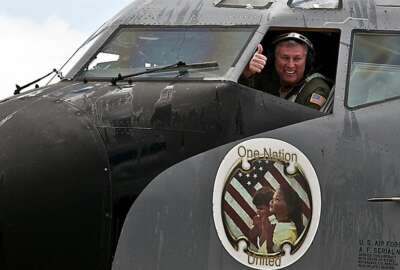

Airlines can start laying off pilots this October, will that help with the pilot shortage?
The Air Force is seeing a small retention uptick with its pilots after the employment slump caused by coronavirus, and it might help with the pilot shortfall the service has been facing in recent years. However, if the disease continues to affect travel, the Air Force may see its shortage drop dramatically this fall.
As of June 26, 222 rated officers have been approved to stay past their original approved retirement and separation dates since the nation started feeling the economic effects of coronavirus in March, according to Air Force spokeswoman Lt. Col. Malinda Singleton. Of those 222, 153 pilots are planning to stay past 2020.
“The Air Force is using existing policy that allows members with an approved future retirement or separation date to withdraw their retirement/separation or extend their retirement/separation date,” Singleton told Federal News Network. “We started this effort on March 11 by sending a message to 575 rated officers. Normally, airmen with an approved separation date are limited to requesting an extension to their date of separation of 90 days or less. However, under this program we offer extensions of up to 12 months. Over 40 rated officers have taken advantage and extended their separation date more than 90 days.”
The extra retention may be because pilots are worried about finding jobs in the civilian world, especially since the airline industry is expected to lose more than $200 billion in 2020.
“We’ve basically been holding our own,” Air Force Chief of Staff Gen. David Goldfein said Wednesday during a video chat with the Brookings Institution. “We’re not significantly improved, we’re not significantly degraded. We have a shortage of about 2,000 and we’ve carried that shortage over the years. We rarely talk about the denominator, that’s 2,000 of 25,000 that we are short. We just continue to manage it.”
Goldfein said the airlines are not hiring and that is helping retention.
However, the 2020 CARES ACT prohibits pilot layoffs and furloughs until Oct. 1. After that, Singleton said, “We might expect to see furloughed pilots requesting to return to active duty after this date and are keeping a close watch on the situation.”
Last year, a Defense Department study showed a grim outlook for the future of pilots in the military services.
About 30,000 pilots were set to retire from commercial airlines by 2026, causing a talent grab for both commercial airlines and the military services over pilots.
However, the impacts of COVID-19 may completely change that trajectory.
The study states that major airline hiring increased steadily from 2012 and during that timeframe the number of eligible Air Force pilots who took aviation bonuses decreased from 67% to 44%.
With airlines taking a big hit from coronavirus they may not be able to offer the jobs, pay or benefits they did in the past.
The Air Force has been looking closely at how it can increase pilot retention.
“Job dissatisfaction, career dissatisfaction, frequent and long deployments, poor quality of life, non-competitive pay and lack of personal and professional development are among the reasons cited for why many experienced military pilots separate from military service,” the DoD study states.
The Air Force has tried to better quality of life and service. It gave pilots more flexibility in professional development pathways, eliminated non-essential training and cut operational and administrative requirements.
The Air Force is also trying to make it easier for airmen to move between full-time and part-time duty so they can take time to be with family, go to school or care for a loved one.
“If we can make flying in the Air Force as rich an experience as we can for all the reasons that someone signed up to join the United States Air Force then we are going to keep them longer,” Goldfein said.
Copyright © 2025 Federal News Network. All rights reserved. This website is not intended for users located within the European Economic Area.
Scott Maucione is a defense reporter for Federal News Network and reports on human capital, workforce and the Defense Department at-large.
Follow @smaucioneWFED


